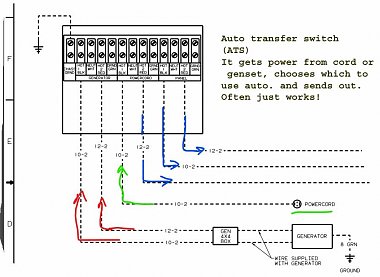Yes, noticed the other post but that will likely be in the chassis and diesel end where I often know almost nothing, so better to get info from others who have ideas.
I feel better on the electrical end of things like the 110AC and coach. We get good info on many of those issues and some on the chassis/start side of it.
I feel like I can do pretty well on explaining how they each are seperate but tie together at different times for different reasons.
So while you are stuck with just wondering on the big issue, how about I just do a rundown of the electrical and batteries, so you don't have as much hazard from them?
Excuse me, please if I go too much in detail on things you may already know. I like to know we get it covered and if you already knew, just ignore that part. No offense intended!
Let me start at where we plug into power.
The 110AC electrical drawings are here:
https://www.winnebago.com/Files/File...001/135425.pdf
And then we run into a question of which model as there are four pages but only one fits your RV as it can be a 30 amp or a 50 amp with different options on each one!
These are ALL for the 36L but lots of different things on each, like the power cord which can be three prongs for hot, neutral and ground, or it can be four prongs, two 110 hot, neutral and ground!
No 220AC involved, just tow 110 hot, so a different plug shape than for stoves or driers!
So step one to knowing your RV, might be to sort if your cord has three or four prongs. If three use one of the first two pages and ignore pages 3 and 4!
And then when finding which of two drawings, 30 or 50 amp, look for whether you have an inverter breaker panel seperate from the main breaker set?
So four choices on which page to look at?
Page 1-30 amp no inverter panel
Page 2 -30 amp with panel
page 3 -50 amp but no panel
page 4 -50 amp with inverter panel.
Reason for starting at the 110 AC side is that is where we get the power to run the converter/charger which charges the batteries.
Kind of like to know how/where the charger gets plugged into the wall??
If you can sort which RV you have, we can cut out a lot of confusion on where things go! When you get time and hands on the RV again, see if one of those match?
Meanwhile all of them have a box for the Auto Transfer Switch (ATO) as a first stop for the power coming from the cord or the generator. That part is pretty much auto and not too much to study. The main thing on them is that power comes in from one or the other as I marked red or green and the ATO chooses which to send out like on the blue lines to the RV.
Click this snip to get a better view.

This drawing gives the physical location of the 110AC things like the transfer switch and again, you need to choose which sheet shows what you have with the ATS down about sheet 9. Usually a big box right where the power cord comes in.
About the only complaint on them seems to be the screws holding the wires can get loose, so if you want to look at them and tighten them , it might be worth the time but not something everybody does! The main thing is that IF they begin to get loose, they arc and burn themselves up and then you get bigger trouble than just checking they are tight.
Don't forget to unplug before sticking a screwdriver in there!!

Forget I said that! I bet you knew that!